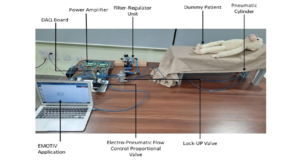 by Ashis Sinha
by Ashis Sinha
IIT-ISM researchers developed a system which controls the pneumatic medical beds through Electroencephalography (EEG) signals generated by the patient’s brain.
A team of researchers of IIT-ISM Dhanbad led by Zafar Alam, Assistant Professor of Mechanical Engineering Department has developed the system to control the pneumatic medical beds through EEG signals.
This research aimed to help paralytic or severely affected patients to control the position of their pneumatic medical beds by the brain through an EEG device, informed Rajni Singh, Dean, Media & Branding of IIT-ISM.
“The system developed as part of a project worth around Rs 2 Lakh of the Institute fund, NVCTI as well as the personal fund is commercially viable compared to available ICU beds,” she added.
The research team, which included B Tech Final Year students Manmohan Labh, Yalla Mark Vishal, and Inampudi Sai Amit and research scholar Ashish Siddharth, completed the project between August 2021 and May 2022 and filed a patent application, claims that their system will improve medical governance by reducing nursing loads at health centers and hospitals, she informed.
Explaining the difficulties faced by some patients, which prompted them to develop the system, Professor Alam said, “With the rise in accidents and paralytic attacks worldwide and consequent rise is disabilities, many patients are restricted to beds in such conditions where self-lifting the bed seems to be an unachievable task”
“The thought behind the project is to enable the paralytic, bedridden person to control or move and fix their medical beds without requiring any physical effort” added Alam.
Elaborating on the technicalities, Professor Alam said, “The brain sends the signal in the human body in the form of small impulses of currents and spikes, also known as Electroencephalography signals through the network of neurons and nervous systems”.
“A study of these signals has been carried out to analyse a person’s thoughts and then with the aid of machine learning, a trained model was obtained to recognize whether the patient wants to lift the bed up or down” elaborated Alam.
“The developed model controls a pneumatic actuated medical bed to the desired position” further said Alam and added that these pneumatic actuators use air as a fluid medium and due to its attribute of compressibility; a cushioning effect is generated that creates an additional advantage to the system.
Justifying the development of the system and its further deployment in the hospital, he said, “For such severely affected patients who cannot move on their own, continuous nursing of their condition is required which increases the load on health and also escalates the cost of medical governance.”
“The aim project is to develop a system or device to control the pneumatic medical bed through electroencephalography signals of the brain by the paralytic patients, which is capable of controlling the movement of the medical bed through powered by a pneumatic cylinder by the patient’s brain,” he added.
Using a pneumatic cylinder-based medical bed is not only cheaper but also has the added advantage of providing a cushioning effect during its motion due to the virtue of compressibility of air, Professor Alam said.



